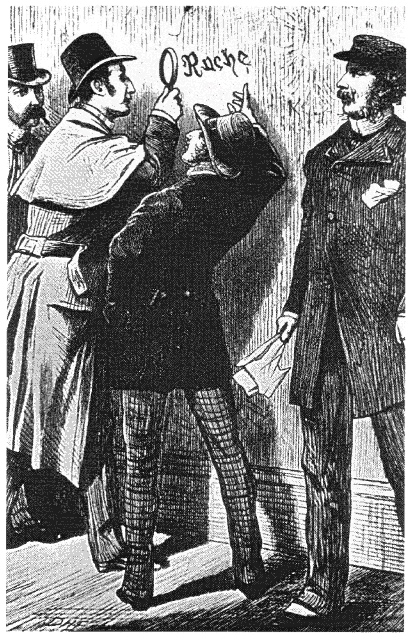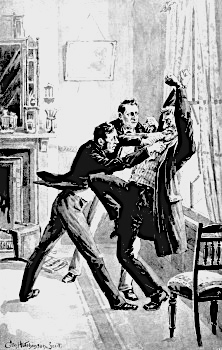“From a drop of water, a logician could infer the possibility of an Atlantic or a Niagara without having heard of one or the other. All life is a great chain, the nature of which is known whenever we are shown a single link of it. Like all other arts, the Science of Deduction and Analysis is one which can only be acquired by long and patient study nor is life long enough to allow any mortal to attain the highest possible perfection in it.” – Sherlock Holmes.
To this academic and philosophical commentary by Sherlock Holmes, the more practical Dr. Watson comments, “What rot is this…What ineffable twaddle!…I never read such rubbish in my life.”
 Written as a biography, not of Arthur Conan Doyle’s life but of the specific influences on his life which led to his successful creation of Sherlock Holmes and Dr. Watson as fictional heroes, Michael Sims presents a fully documented and carefully researched study of Arthur Conan Doyle (1859 – 1930) and how he eventually achieved success as the author of the wildly popular Sherlock Holmes novels. Born in Scotland, Doyle, twenty-seven years old, was working full-time as a physician in Portsmouth, England when he started working on his first novel, A Study in Scarlet. He had always admired how his favorite teacher in medical school, Dr. Joseph Bell, was able to tell unfathomable amounts of information about his patients by paying attention to the tiniest of details – observations about their physical condition, appearance, past history, and reasons for seeking medical help. The personal physician to Queen Victoria whenever she visited Edinburgh, Bell was widely respected throughout the city, and Doyle believed that Bell’s observant and effective approach to patients would greatly improve detective stories if those methods were used by detective heroes.
Written as a biography, not of Arthur Conan Doyle’s life but of the specific influences on his life which led to his successful creation of Sherlock Holmes and Dr. Watson as fictional heroes, Michael Sims presents a fully documented and carefully researched study of Arthur Conan Doyle (1859 – 1930) and how he eventually achieved success as the author of the wildly popular Sherlock Holmes novels. Born in Scotland, Doyle, twenty-seven years old, was working full-time as a physician in Portsmouth, England when he started working on his first novel, A Study in Scarlet. He had always admired how his favorite teacher in medical school, Dr. Joseph Bell, was able to tell unfathomable amounts of information about his patients by paying attention to the tiniest of details – observations about their physical condition, appearance, past history, and reasons for seeking medical help. The personal physician to Queen Victoria whenever she visited Edinburgh, Bell was widely respected throughout the city, and Doyle believed that Bell’s observant and effective approach to patients would greatly improve detective stories if those methods were used by detective heroes.
Doyle’s medical practice was not hugely successful, and as he had always enjoyed writing, he had been spending his spare time writing stories of mystery, adventure, and the supernatural as a way to augment his income. He was married, his practice was limited, and he did manage to sell a few stories, written anonymously, to magazines and newspapers where they were often serialized. When he started writing his first novel, however, he had no experience in writing complex detective stories, so he looked to authors from the past for examples. Edgar Allan Poe’s August Dupin, Emile Gaboriau’s Monsieur Lecoq, Charles Dickens’s Inspector Bucket from Bleak House, Wilkie Collins’s Sgt. Cuff from The Moonstone, and in the United States, Anna Katharine Green’s New York policeman Ebenezer Gryce from The Leavenworth Case were all favorite detectives, and he studied them to see what made them successful with an audience. None of these earlier authors, were physicians, however, and the recent developments in medicine such as the use of anesthesia, painkillers, and opium, along with new approaches to learning patients’ histories, as used by Dr. Bell, opened many possibilities for new, unique twists in Doyle’s stories and their solutions. His background, too, especially his familiarity with the methods of his mentor, Dr. Joseph Bell, toward patients, made him particularly sensitive to the need for careful observation and the use of deductive reasoning.
By keeping his plots logical and deductive, Doyle hoped to avoid the usual trick of relying on surprises, tricks, and coincidences to solve a case. This also allowed him to involve his audience more directly in the plots of his stories, as his readers, too, tried to use their own deductive skills to identify the villain.
A Study in Scarlet, Holmes’s first novel (1887), opens without formality as one character, Dr. John Watson, is looking for a place to live and someone with whom he might share an apartment. A friend mentions that someone named Sherlock Holmes (originally scheduled to be named Sherrinford Holmes) was looking for a roommate, and Watson decided to apply, not knowing what Holmes did for a living but assuming him to be a medical student. “He’s a little queer in his ideas,” the friend asserts, “an enthusiast in some branches of science…His studies are very desultory and eccentric, but he has amassed a lot of out-of-the-way knowledge which would astonish his professors….He is a little too scientific for my taste – it approaches to cold-bloodedness.” The friend even states that “I could imagine him giving a friend a little pinch of the latest vegetable alkaloid, not out of malevolence, you understand, but out of a spirit of inquiry in order to have an accurate idea of the effects,” all these descriptors actually being applicable to Doyle himself, including the experimentation with pills.

Original illustration of Holmes with magnifying glass, by D. H. Friston, 1887.
In addition to analyzing the writing of this novel, biographer Michael Sims provides detailed information regarding Holmes’s publisher, who cheated him; Doyle’s efforts to help his alcoholic father, an institutionalized artist, by making him an illustrator of his book; and his own efforts to finish his full-length novel. His efforts were exhausting, but Doyle, who had become a spiritualist, by then, soldiered on with his writing. His use of a legion of Mormons as the villains in this first novel was considered exotic, rather than hurtful and wrong, and he did not hesitate to use aboriginal pygmies of the Andaman Islands as characters in his second novel, The Sign of Four (1890), with one of them being a killer. By the three-quarter point of this biography, Doyle had hired a literary agent, a new profession at the time, and the agent had succeeded in finding him a publisher for a collection of short stories. Illustrations in this book show Sherlock Holmes wearing his deerstalker hat, instead of the top hat he wore in the first novel.

George Wylie Hutchinson, also an illustrator for the first edition of A Study in Scarlet, a fight in the climactic last scene.
Filled with detailed information on the history of the mystery genre, even including references to the Book of Daniel in the Bible, and allusions to many authors of the eighteenth and nineteenth centuries, biographer Michael Sims presents information and footnotes which would make a thesis advisor proud. The extent to which a reader less interested in the research aspects would enjoy this information is open to question. Sims does tie it all to Arthur Conan Doyle’s life and his early works, and many, if not most lovers of Doyle’s mysteries will probably find it fascinating. All this literary history and its obvious ties to the social and intellectual history of the period add depth and insight into Doyle’s work, and Michael Sims’s descriptive writing makes this a fairly fast read, despite its freight of research.
Photos: The author’s photo is from http://westportlibrary.org
The original cover on Beeton’s Annual in 1887 advertised Doyle’s Arthur and Sherlock: https://en.wikipedia.org
A Study in Scarlet, Doyle’s first novel, also provided the first picture of Sherlock Holmes with his famed magnifying glass, by illustrator D. H. Friston: https://en.wikipedia.org/
Also from A Study in Scarlet is this illustration by George Wylie Hutchinson, also an illustrator for the novel: This is the climactic fight scene. https://en.wikipedia.org/


